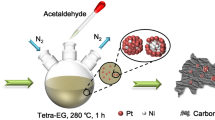Abstract
Metal nitride clusterfullerenes (NCFs) have significant applications in molecular electronics, biomedical imaging, and nonlinear optical devices due to their unique structures. However, their wide applications are limited by the production quantity. In this work, the yields of metal nitride clusterfullerenes M3N@C80 (M=Y, Sc, Gd) were greatly enhanced by utilizing zirconium nitride (ZrN) as an efficient nitrogen source for the arc-discharge method. Compared with the traditional synthetic route using N2 gas as nitrogen source, the ZrN inside graphite tube can be vaporized simultaneously with metal and graphite, and then afford the high concentration of nitrogen atoms in the arc region, which will promote the formation of metal nitride clusterfullerenes finally. The ZrN can promote the yields of Y3N@C80, Sc3N@C80 and Gd3N@C80, revealing the universal applicability of ZrN as a highly efficient nitrogen source. Specifically, the yield of Sc3N@C80 was greatly improved when adding ZrN, and it shows over double yield compared to traditional synthetic route using N2 gas. In addition, ZrN can also enhance the yields of paramagnetic azametallofullerene M2@C79N due to the high concentration of nitrogen atoms in the arc region. This new method enhances the production quantity of metal nitride clusterfullerenes and azametallofullerenes, and it will greatly promote the research and application of these molecular carbon materials.

Similar content being viewed by others
References
Stevenson S, Rice G, Glass T, Harich K, Cromer F, Jordan MR, Craft J, Hadju E, Bible R, Olmstead MM, Maitra K, Fisher AJ, Balch AL, Dorn HC. Nature, 1999, 402: 898
Cardona CM, Elliott B, Echegoyen L. J Am Chem Soc, 2006, 128: 6480–6485
Li T, Murphy S, Kiselev B, Bakshi KS, Zhang J, Eltahir A, Zhang Y, Chen Y, Zhu J, Davis RM, Madsen LA, Morris JR, Karolyi DR, LaConte SM, Sheng Z, Dorn HC. J Am Chem Soc, 2015, 137: 7881–7888
Ross RB, Cardona CM, Guldi DM, Sankaranarayanan SG, Reese MO, Kopidakis N, Peet J, Walker B, Bazan GC, Van Keuren E, Holloway BC, Drees M. Nat Mater, 2009, 8: 208–212
Zhang J, Stevenson S, Dorn HC. Acc Chem Res, 2013, 46: 1548–1557
Rincón-García L, Ismael AK, Evangeli C, Grace I, Rubio-Bollinger G, Porfyrakis K, Agraït N, Lambert CJ. Nat Mater, 2016, 15: 289–293
Toth K, Molloy JK, Matta M, Heinrich B, Guillon D, Bergamini G, Zerbetto F, Donnio B, Ceroni P, Felder-Flesch D. Angew Chem Int Ed, 2013, 52: 12303–12307
Zalibera M, Krylov DS, Karagiannis D, Will PA, Ziegs F, Schiemenz S, Lubitz W, Reineke S, Savitsky A, Popov AA. Angew Chem Int Ed, 2018, 57: 277–281
Han Z, Wu XH, Roelle S, Chen CH, Schiemann WP, Lu ZR. Nat Commun, 2017, 8: 692
Popov AA, Yang S, Dunsch L. Chem Rev, 2013, 113: 5989–6113
Dunsch L, Krause M, Noack J, Georgi P. J Phys Chem Solids, 2004, 65: 309–315
Stevenson S, Mackey MA, Thompson MC, Coumbe HL, Madasu PK, Coumbe CE, Phillips JP. Chem Commun, 2007, 4263
Yang S, Zhang L, Zhang W, Dunsch L. Chem Eur J, 2010, 16: 12398–12405
Jiao M, Zhang W, Xu Y, Wei T, Chen C, Liu F, Yang S. Chem Eur J, 2012, 18: 2666–2673
Liu F, Guan J, Wei T, Wang S, Jiao M, Yang S. Inorg Chem, 2013, 52: 3814–3822
Fix R, Gordon RG, Hoffman DM. Chem Mater, 1991, 3: 1138–1148
Lind H, Pilemalm R, Rogstrom L, Tasnadi F, Ghafoor N, Forsen R, Johnson LJS, Johansson-Joesaar MP, Oden M, Abrikosov IA. AIP Adv, 2014, 4: 127147
Stevenson S, Thompson MC, Coumbe HL, Mackey MA, Coumbe CE, Phillips JP. J Am Chem Soc, 2007, 129: 16257–16262
Acknowledgements
This work was supported by the National Natural Science Foundation of China (51832008, 51672281, 51972309), and the Youth Innovation Promotion Association of CAS (2015025).
Author information
Authors and Affiliations
Corresponding authors
Additional information
Conflict of interest
The authors declare no conflict of interest.
Rights and permissions
About this article
Cite this article
Lu, Y., Zhang, J., Zhao, C. et al. Zirconium nitride as a highly efficient nitrogen source to synthesize the metal nitride clusterfullerenes. Sci. China Chem. 64, 29–33 (2021). https://doi.org/10.1007/s11426-020-9843-2
Received:
Accepted:
Published:
Issue Date:
DOI: https://doi.org/10.1007/s11426-020-9843-2




